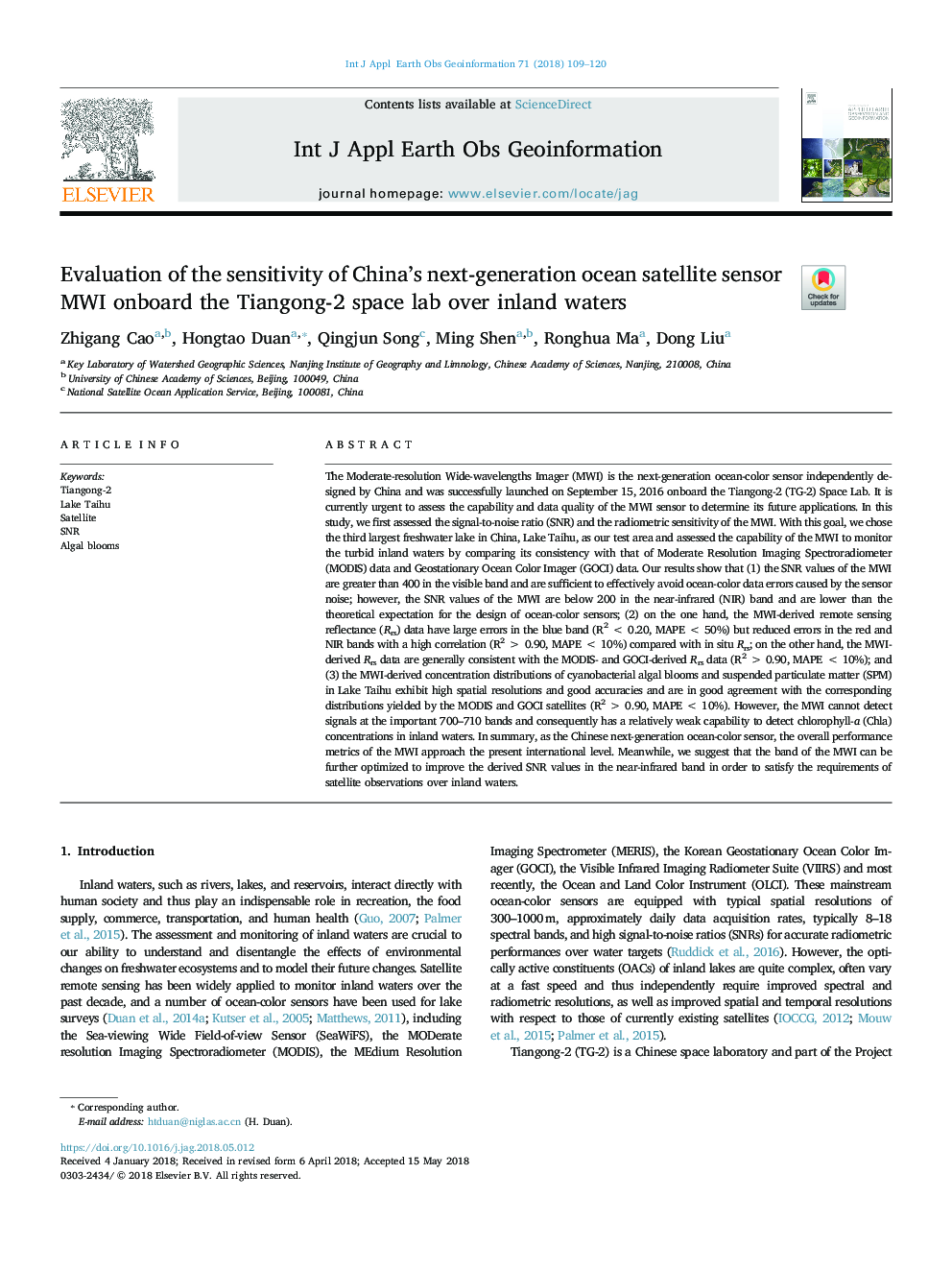| کد مقاله | کد نشریه | سال انتشار | مقاله انگلیسی | نسخه تمام متن |
|---|---|---|---|---|
| 8867811 | 1621786 | 2018 | 12 صفحه PDF | دانلود رایگان |
عنوان انگلیسی مقاله ISI
Evaluation of the sensitivity of China's next-generation ocean satellite sensor MWI onboard the Tiangong-2 space lab over inland waters
دانلود مقاله + سفارش ترجمه
دانلود مقاله ISI انگلیسی
رایگان برای ایرانیان
موضوعات مرتبط
مهندسی و علوم پایه
علوم زمین و سیارات
کامپیوتر در علوم زمین
پیش نمایش صفحه اول مقاله

چکیده انگلیسی
The Moderate-resolution Wide-wavelengths Imager (MWI) is the next-generation ocean-color sensor independently designed by China and was successfully launched on September 15, 2016 onboard the Tiangong-2 (TG-2) Space Lab. It is currently urgent to assess the capability and data quality of the MWI sensor to determine its future applications. In this study, we first assessed the signal-to-noise ratio (SNR) and the radiometric sensitivity of the MWI. With this goal, we chose the third largest freshwater lake in China, Lake Taihu, as our test area and assessed the capability of the MWI to monitor the turbid inland waters by comparing its consistency with that of Moderate Resolution Imaging Spectroradiometer (MODIS) data and Geostationary Ocean Color Imager (GOCI) data. Our results show that (1) the SNR values of the MWI are greater than 400 in the visible band and are sufficient to effectively avoid ocean-color data errors caused by the sensor noise; however, the SNR values of the MWI are below 200 in the near-infrared (NIR) band and are lower than the theoretical expectation for the design of ocean-color sensors; (2) on the one hand, the MWI-derived remote sensing reflectance (Rrs) data have large errors in the blue band (R2â¯<â¯0.20, MAPEâ¯<â¯50%) but reduced errors in the red and NIR bands with a high correlation (R2â¯>â¯0.90, MAPEâ¯<â¯10%) compared with in situ Rrs; on the other hand, the MWI-derived Rrs data are generally consistent with the MODIS- and GOCI-derived Rrs data (R2â¯>â¯0.90, MAPEâ¯<â¯10%); and (3) the MWI-derived concentration distributions of cyanobacterial algal blooms and suspended particulate matter (SPM) in Lake Taihu exhibit high spatial resolutions and good accuracies and are in good agreement with the corresponding distributions yielded by the MODIS and GOCI satellites (R2â¯>â¯0.90, MAPEâ¯<â¯10%). However, the MWI cannot detect signals at the important 700-710 bands and consequently has a relatively weak capability to detect chlorophyll-a (Chla) concentrations in inland waters. In summary, as the Chinese next-generation ocean-color sensor, the overall performance metrics of the MWI approach the present international level. Meanwhile, we suggest that the band of the MWI can be further optimized to improve the derived SNR values in the near-infrared band in order to satisfy the requirements of satellite observations over inland waters.
ناشر
Database: Elsevier - ScienceDirect (ساینس دایرکت)
Journal: International Journal of Applied Earth Observation and Geoinformation - Volume 71, September 2018, Pages 109-120
Journal: International Journal of Applied Earth Observation and Geoinformation - Volume 71, September 2018, Pages 109-120
نویسندگان
Zhigang Cao, Hongtao Duan, Qingjun Song, Ming Shen, Ronghua Ma, Dong Liu,